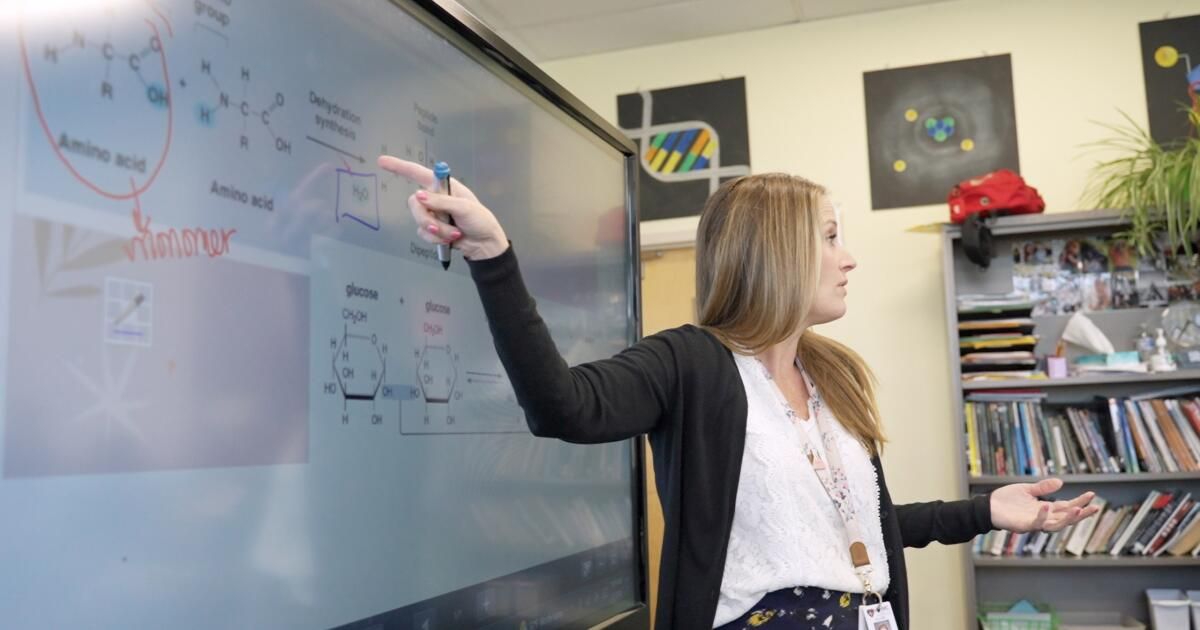Like many high school chemistry teachers, Angie Hackman said she teaches students about atoms, matter and how they “influence the world around us.”
But Hackman also has another responsibility: developing students’ literacy skills. He closely reads passages from their textbooks, picking out prefixes and suffixes and identifying word roots. He dissected the word “intermolecular” and its prefix, “inter,” by relating it to other words with that same prefix.
All the teachers at his San Diego charter school, Health Sciences High School and Middle Schoolteaches students literacy skills, regardless of the subject. That's because many students come to school struggling with basic reading, some scoring in the first or second grade, said Douglas Fisher, a school administrator.
The goal is for high school graduates to reach “college-ready reading levels.”
The school has expected teachers to integrate literacy into their lessons since its founding in 2007. To help them succeed, the school, which last year enrolled about 1,000 students, 500 high school studentsof which approximately 80% qualified for free or reduced-price lunch, provides its teachers with daily professional development and training on literacy instruction and other topics.
Research suggests that while some students catch up with their peers after individual interventions, a bigger impact may come from integrating reading instruction into other classes, “where these kids spend the majority of their day,” said Jade Wexler, a professor of special education with a focus on adolescent literacy at the University of Maryland.
A handful of school districts and states, including Idaho and Ohio, are beginning to explore this approach.
Poor reading skills are a nationwide problem. In the 2022 National Assessment of Educational Progress, known as the Nation's Report Card, nearly 100 percent of students were reading poor. 70% of eighth graders scored below “proficient” And of those, 30% scored “below basic,” roughly the same as California.
In the Los Angeles Unified School District, 72% of eighth-graders scored below proficient and 33% below basic in 2022.
“In a typical classroom of about 25 kids, that means about 17 are still struggling to understand the text at the most basic level,” Wexler said.
This may be due, in part, to broader problems with literacy instruction. For decades, the primary methods for teaching students to read in the U.S. were out of line with evolving researchknown as “the science of reading.”
A large body of research indicates that students need explicit instruction in basic reading skills, such as phonics, in order to recognize and make sense of words on the page. But many schools have also used a rival curriculum called the “whole language” approach, which generally deemphasizes phonics.
Some high school teachers see the consequences, Wexler said.
“Many middle school students have difficulty decoding multisyllabic words, for example, the longer words they encounter in science or social studies texts,” Wexler said. “We also have many children who can decode these words at acceptable levels and with fluency, but still have difficulty comprehending the text they are reading.”
In recent years, school systems have begun to make changes. Between 2019 and 2022, more than 200 laws were enacted to reform reading instruction in 45 states and the District of Columbia, according to A report by the Albert Shanker Institute.
According to the Shanker Institute, California passed nine bills related to reading reform in that period.
However, a bill was passed to regulate the “science of reading.” placed on the table During the last legislative session, the California Teachers Association opposed the bill. saying that it was A “one-size-fits-all” approach that could undermine literacy instruction, which is already rooted in the science of reading. In addition, the proposal did not meet the needs of English learners.
Some experts and educators fear that reading reforms have left older students behind.
Susan B. Neuman, the report's lead author and a professor of education at New York University, said high schools were the least affected by the wave of legislation through 2022.
“It’s primarily geared toward the early grades,” Neuman said. “You could even say that grades four through six have been left behind a little bit.”
Kayla Reist, another author of the Shanker Institute report, said that if states were to start focusing on high school students in reading reform legislation, they would “really have to start talking about teacher preparation programs” and professional development. That’s because many high school teachers finish their training without lessons on how to teach reading, which typically focuses on the early grades.
In a Practical guide 2008 In an article on how to improve adolescent literacy, the Institute of Education Sciences, a research institution within the U.S. Department of Education, stated that “many teachers say they do not feel prepared to help their students or that they do not believe that teaching reading skills in content-area classes is their responsibility.”
“If you're a science teacher and you want to teach science, you really don't want to be stuck talking about the academic vocabulary of science,” Neuman said.
While some states have passed laws to better prepare middle and high school teachers to teach literacy, California is not among them.
In response to questions, the California Department of Education said one of California Superintendent of Public Instruction Tony Thurmond's top priorities is an initiative called Reading from third grade onwardsa plan to ensure that all California students learn to read by third grade by 2026.
Wexler, the literacy expert, is researching ways to create a school-wide literacy model at the secondary level. That could include strategies like the one adopted by Health Sciences High.
Kimberly Elliot, a teacher educator at the school, said teachers across all subject areas are receptive to literacy training, but instruction is different in different classrooms.
“Close reading in a science class may be slightly different than helping students solve a math problem,” Elliot said.
While Hackman, the chemistry teacher, spends a lot of class time reading articles, Maggie Fallon, the math teacher, said she primarily supports literacy by teaching students new vocabulary.
“It's more like figuring out what word is equivalent to a math symbol,” Fallon said, explaining that she often asks her students to write down word problems to derive meaning.
Faiza Omar, who attended Hackman's class last year as a junior, learned English as a second language and didn't receive basic reading interventions until high school. She said the extra reading review in her core subject classes helped “make sure everyone is on the same page.”
“It allows me to understand what is happening,” Omar said.
This story It was produced by The Hechinger Reportan independent, nonprofit news organization focused on inequality and innovation in education.












